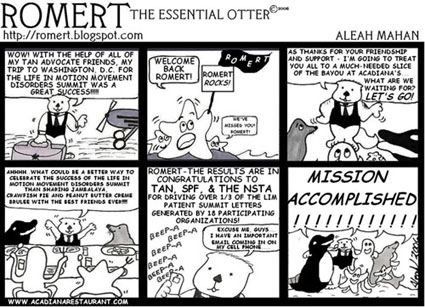|
Life in Motion Movement Disorders Patient Summit Prior to the Summit, more than 4,000 Americans from every state reached out to their Congressional representatives and educated them about movement disorders via the Life in Motion Letter-writing Campaign. Congressman Danny Davis (D-IL), the keynote speaker at the Summit and sponsor of legislation to designate October as national Movement Disorders Awareness Month, spoke about the struggles people with movement disorders experience while seeking a diagnosis. He also noted that the Summit and Movement Disorders Awareness Month are meant to call attention to these devastating conditions and demonstrate why resources are needed to help people receive faster diagnoses and effective, up-to-date treatment. Showcased at the Summit was the Life in Motion Movement Disorders Experience Center, an interactive exhibit designed to educate people about movement disorders through the use of devices that “simulate” the challenges a person with a movement disorder encounters each day. The Center, which will be exhibited at hospitals around the country during October’s Movement Disorders Awareness Month, simulates several conditions including dystonia, Parkinson’s disease, restless legs syndrome, spasticity and tremor. Among the Summit speakers was Daniel Tarsy, M.D., Professor in Neurology, Harvard Medical School and Director of the Parkinson’s Disease & Movement Disorders Center, Beth Israel Deaconess Medical Center, who noted that “once accurately diagnosed, movement disorders are often treatable, but the lack of awareness may cause patients to live for years with conditions that can result in the loss of one’s career, family or independence.” Also speaking at the event were Ruth Hagestuen, R.N., M.A., Director of Field Services, National Parkinson Foundation; Judith Blazer, M.S., Executive Director, WE MOVE; Brad Gary, Vice President of Government Relations at Allergan, Inc., funders of the Life in Motion campaign; and two individuals living with movement disorders, Ross Hoffman, M.D., a cardiologist living with limb dystonia, and Stephanie Liem, a concert organist and conductor living with tremor. Dr. Hoffman, whose son is challenged with generalized dystonia, recently reduced the size of his cardiology practice to devote time to raising awareness and finding a cure for dystonia and other movement disorders. He spoke on the need for physicians to develop a better understanding of the symptoms of movement disorders as well as the treatments that are currently available, but often underutilized. “Breakthroughs such as treatment with botulinum toxin and deep brain stimulation (DBS) have greatly improved the lives of many people affected by movement disorders,” Dr. Hoffman noted. “However, further breakthroughs are possible only if we can drive support among the medical community and the public for continued research into these debilitating conditions.” Amy Comstock, Esq. of the Parkinson’s Action Network concluded the day’s events with a discussion about working with government. She provided valuable information about lobbying congressional representatives and the importance of having a cohesive legislative agenda. At the close of the Summit, Judith Blazer of WE MOVE commented, “The message from today’s Summit is clear: there are 40 million Americans living with movement disorders which can have a devastating impact on quality of life and affect the entire family. The path to diagnosis is often difficult and unnecessarily long. Effective treatments are available but are not always accessible. WE MOVE will meet these challenges by continuing to education physicians and other healthcare professionals about movement disorders and by collaborating with the movement disorder community via the Life in Motion campaign to improve the quality of life for all persons living with movement disorders.”
Reference: Life in Motion, 2006. Life in Motion Announcement.
Life in Motion Letter Writing Campaign Eighteen member organizations of the LIM Coalition elected to participate in the Letter-writing Campaign. Of the total 4,000 letters generated, these 18 organizations accounted for 2,729 of the letters sent to Congressional representatives. Three organizations were responsible for driving over one third of the letters generated by participating organizations, representing over 50% of the effort toward the campaign initiative (as measured by percentage of declared membership involved in the campaign). CONGRATULATIONS to…
The three organizations received grants recognizing their efforts in driving their membership/constituency to participate in the Letter-writing Campaign. Every organization received grant funds reflective of the number of letters generated by their membership.
Reference: Life in Motion, 2006. Life in Motion Announcement.
Feedback from Tremor Action Network Participants: I joined in the letter writing campaign to Congress as I feel many people suffer with this affliction. I and others will be watching developments on September 14th as these letters are submitted to our elected officials. Thank you. –Chris Please take the time to do this. My sister has become totally handicapped by this disease. We need to get more research and help, to stop or help treat this disease. –Sandra Keep fighting the fight!!! –Ann I was able to submit my support to the Legislators. –Jane Glad to help and I hope it really gets somewhere so some light comes in the window. –Judy I give TAN permission to sign me up for the Letter Writing Campaign to support those of us with ET, and more than 40 million Americans with a movement disorder. –Debra I am happy to support your efforts on behalf of all the many Americans with these types of disorders. –Amy You have been doing a great job on behalf of 40 million Americans who are suffering from some form of movement disorders. –Chris K
Tremor Watchdogs |
